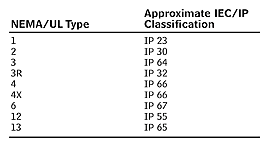All electrical equipment enclosures are designed to provide protection against accidental contact with the enclosed equipment and emission of sparks or flame from failure of internal components. In addition, enclosures provide varying degrees of protection against the external environment. Approval of electrical equipment enclosures for the environment is a requirement of the National Electrical Code and critical to the long-term performance of hvacr equipment.
U.S. Standards
Industry standards for electrical enclosures in the United States are published by the National Electrical Manufacturer’s Association (NEMA) and Underwriter’s Laboratories (UL). The following reference standards should be included in specifications for equipment that include control panels or motor starters: NEMA 250 — Enclosures for Electrical Equipment (1,000 Volts Maximum); UL 50 — Enclosures for Electrical Equipment; and UL 508 — Industrial Control Equipment.
These standards establish basic construction requirements as well as test methods. They define the degree of environmental protection according to a type number common to all U.S. manufacturers.

Enclosure Types
Although the detailed definitions of protection afforded by a particular enclosure type may differ slightly between the NEMA and UL standards, the basic conditions of application are accurately summarized in Table 1.Not all enclosure types are available from any given manufacturer, so review the options offered and choose the type that meets or exceeds the requirements of the application. A higher degree of performance generally means higher cost, so avoid the temptation to over-specify.
Type 2, Type 6 and Type 13 enclosures are limited to special applications, not for most hvacr equipment.

IEC Standards
Enclosures manufactured in Europe must meet the standards of the International Electrotechnical Commission (IEC). They are classified by the letters IP and two characteristic numerals; the first (0-6) identifies the degree of protection against solid objects, including dust, and the second (0-8) the degree of protection against water.The number of different enclosure classifications possible (48) under the IEC standard is much greater than the number under the NEMA and UL standards. IEC standards tend to allow more application-specific designs, while U.S. standards cover a broad range of applications with a fewer number of ratings. One manufacturer offers a cross-reference of NEMA Type numbers to IP classifications (Table 2).
As Always – Coordinate
Coordinate the enclosure types you specify for hvacr equipment with the electrical designer. Chances are, they are placing electrical equipment in the same spaces you are placing boilers, chillers, and fans and have addressed the enclosure requirements. Many electrical construction specifications include a general section defining area classifications and enclosure types that you can reference in your specifications.None of the above information applies to locations where flammable or explosive liquids, gases, fibers, or dusts are present. Enclosures for these areas must comply with more stringent requirements and be approved for the type and ignition characteristics of the hazardous substance. Seek direction from an electrical engineer qualified in hazardous location design for equipment requirements.

